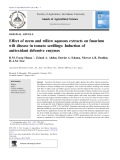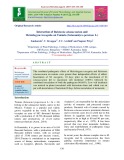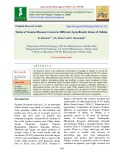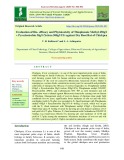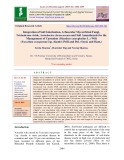
Maximum wilt incidence
-
The results showed that the percentage of disease incidence was increased in non treated tomato seedlings in time dependent manner and reached the maximum level (65%) after 6 weeks of infection. Treatments of tomato plants with neem and willow aqueous extracts reduced the percentage of disease incidence to the level of 25.5% and 27.8% after 6 weeks of infection respectively.
 7p
7p  schindler
schindler
 30-12-2021
30-12-2021
 10
10
 0
0
 Download
Download
-
The combined pathogenic effects of Meloidogyne incognita and Ralstonia solanacearum on tomato were greater than independent effects of either. Inoculation of M. incognita, 10 days prior to the inoculation of R. solanacearum led to maximum wilt incidence (100%) followed by combined inoculation of both the pathogens (66.66%). Low wilt incidence was noticed in plants inoculated with bacterium alone and which was on par with inoculation of bacterium10 days before inoculation of nematode.
 5p
5p  angicungduoc8
angicungduoc8
 07-11-2020
07-11-2020
 13
13
 1
1
 Download
Download
-
Ganoderma wilt of coconut, caused by Ganoderma spp. is one of the most important constraints limiting coconut production and productivity in Southern Karnataka. The incidence of Ganoderma wilt of coconut during the year 2015-16 ranged from 0 to 47 per cent in southern dry tracts of Karnataka among 356 gardens surveyed. Tumkur recorded maximum incidence (16.75 %) followed by Chitradurga (14.86 %) and Hassan (11.12 %) among four districts surveyed.
 17p
17p  angicungduoc6
angicungduoc6
 22-07-2020
22-07-2020
 12
12
 2
2
 Download
Download
-
An intensive survey was conducted at flowering to ripening of capsule to record the incidence of charcoal rot in ten agroclimatic zones of Odisha during rabi 2014-15. Almost all the fields were infected by more than one disease. The major diseases of sesame recorded were Macrophomina stem and root rot, Cercospora leaf spot, Alternaria blight, powdery mildew, phytopthora blight and phyllody to some extent. Incidence of foliar diseases such as Alternaria blight, Powdery mildew, Cercospora leaf spot ranged from grade 2-4, 0-3 and 1-2 respectively with maximum incidence at Balianta.
 4p
4p  angicungduoc5
angicungduoc5
 14-06-2020
14-06-2020
 7
7
 0
0
 Download
Download
-
The present investigation was conducted to assess the wilt/root rot incidence in chilli (Capsicum annum) in Kashmir and to examine management practices. Survey was carried out in three districts of Kashmir viz., Ganderbal, Baramullah and Pulwama during 2016. Damping-off and wilt/root rot incidence in the districts varied from 7-34 and 11-52% respectively with maximum in disease incidence in district in Ganderbal and minimum in Pulwama. The pathogens responsible for wilt/root rot are Fusarium pallidoroseum, F. oxysporum, F. solani, Phytophthora capsici, R.
 9p
9p  caygaocaolon4
caygaocaolon4
 01-04-2020
01-04-2020
 9
9
 0
0
 Download
Download
-
Tomato is one of the potential vegetable crops both under protected and open field conditions in mid hills of Himachal Pradesh. The production under protected as well as open conditions has suffered in mid hills of HP due to biotic and abiotic stresses. Among biotic stresses bacterial wilt caused by Ralstonia solanacearum is the most devastating disease under protected as well as open field conditions in mid hills of HP which reduces tomato yield to very low levels.
 6p
6p  trinhthamhodang3
trinhthamhodang3
 12-02-2020
12-02-2020
 37
37
 0
0
 Download
Download
-
Chickpea, (Cicer arietinum L.) is one of the most important pulse crops of India, which belongs to family Fabaceae. It occupies very important position in semiarid farming system both for human nutrition and restoring the soil fertility. Occurrence of dry root rot caused by Rhizoctonia bataticola (Taub.) Butler is emerging as a serious biotic constraint in recent years for successful and profitable cultivation of chickpea the efficacy of various fungicides viz.
 5p
5p  nguaconbaynhay3
nguaconbaynhay3
 07-02-2020
07-02-2020
 12
12
 0
0
 Download
Download
-
Cotton is an important crop used globally for its natural fibre and seed. Fusarium wilt, caused by the fungus Fusarium oxysporum f. sp. vasinfectum, is a major disease of cotton capable of causing significant economic loss. The fungus persists in soil as chlamydospores and in association with the roots of susceptible, resistant and non-cotton hosts as well as in seed. In the present investigation, the major cotton growing areas of Tamil Nadu were surveyed for assessing the per cent wilt incidence, the maximum disease incidence of 28.
 7p
7p  nguathienthan2
nguathienthan2
 19-12-2019
19-12-2019
 11
11
 1
1
 Download
Download
-
Studies were conducted on Carnation (Dianthus caryophyllus L.) to find out the effect of integrated inoculation of potent native isolates of Arbuscular mycorrhizal fungi (AM fungi) and Azotobacter chroocococum with other approaches of management like cultural and biological methods in solarized soil on the incidence of wilt caused by Fusarium oxysporum f.sp. dianthi (Prill. and Del.). Initially, organic amendments, botanicals and bio-control agents were evaluated against wilt to find out the best treatments. Among amendments, neem cake was found most effective with 75.
 16p
16p  nguaconbaynhay1
nguaconbaynhay1
 04-12-2019
04-12-2019
 21
21
 1
1
 Download
Download
CHỦ ĐỀ BẠN MUỐN TÌM









